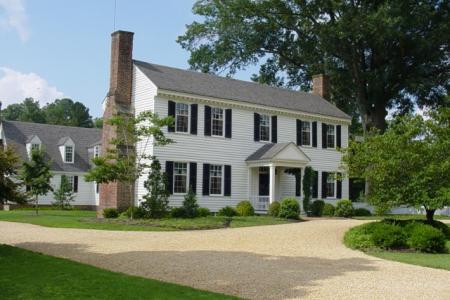House Style - The Colonial Revival

The nation’s centennial celebration in 1876 had many American’s clambering for the past and a return to America’s historic roots. The following year, this spark of interest in early colonial settlers was further fueled by a collection of noted architects, among them McKim, Mead, and White. Upon completing a tour of the original homes of New England, the group took up the battle-cry to preserve these “important colonial houses,” which at this point had begun to age into states of disrepair, and to create new connections to the country’s treasured past with the design and construction of new homes that would further this homage.
By the early 1880’s, these re-imagined colonial homes had begun to spring up all over the eastern seaboard, ushering in the era of the colonial revival. Though many architectural historians divide this era into two distinct groupings, first wave: 1880-1945 and neo-colonial: post-WWII, the popularity of this house-style has generally been unwavering and it continues to be a stalwart of modern construction.
Characteristics
Compared with its Victorian predecessor, the colonial revival exhibits understated elegance. Clean lines, restrained décor, and exterior symmetry are the hallmarks of the style. Roofs are generally simple gable, gambrel or hipped. Dormers may or may not be present. While subtle adornments are sometimes evident, such as dental trim and corner quoins, the exterior of the colonial utilizes plain clapboard or shingles. Houses built after 1920 might also make use of a veneer overlay, like brick or stone, as this fabricated enclosure became more technologically possible around this time. Designers of the revival wanted to celebrate the elements of the original colonial home, but thankfully not at the expense of modernity. To that end, the colonials of the late 19th century made good use of advances in glass work and featured larger, double-hung windows.
Colonial revivals feature two or more stories, though some enjoy the benefits of one story rooms and enclosures added to the wings of the house, a measured nod to the rambling homes of early colonists. One might say that the feature best associated with the colonial revival is the stately front entrance, often pronounced by columns or sidelights. It serves to draw guests into the main hall and into the heart of the house. Perhaps this helps to explain the enduring appeal of this style; for all its understated simplicity, it welcomes you home with open arms.
The Colonial Revival might be perfect for you if:
- you want space: This is a family house. Most are a perfect fit for families of 4 or more people. Living rooms, dens, kitchens, dining rooms, three-season porches, studies, parlors…you get the idea. If you need space, you can probably find a colonial revival that will give you what need and more.
- you like clean lines: This house-style’s symmetry and presentation provide a portrait that is dignified and timeless. It somehow strikes the balance between simple and elegant. This is the perfect house-style for those who prefer restraint over frivolity.
- you’re a fan of tradition: If you’re looking to live in the quintessential American house, the colonial revival might just be for you. With its roots in the Revolution, this house-style has come to represent American history and traditions. The front door alone seems to beckon you to enter and begin creating traditions of your own. Do you dream of being gathered around a dining room table this Thanksgiving? A colonial revival is a Norman Rockwell picture just waiting to be taken.
This might not be your dream home if:
- you are trying to downsize: These homes are built to be spacious. While you can find some mid-sized examples, a colonial revival would never be described as “small and cozy.” Most average three or more bedrooms, along with a dining room, living room, den, enclosed porch, and kitchen. And stairs. With bedrooms tucked up on the second floor, and many with walk-up attics and full basements, this is not the right house for you if you have an eye toward one-floor living.
- you like to mix it up: These are lovely and sensible homes. Elegant? Yes. But also predictable, straight-forward, and traditional. If you want to live in a house that’s unique or quirky, keep looking. This is probably not a style for the wild-at-heart.
- you want a historic house: Yes, these houses can be very old, especially those built before the 1920’s, but that doesn’t mean that most of them are. Because of their popularity, there are literally thousands of homes built in the colonial revival style, and most of them do not bring much pre-WWII history with them. If owning a piece of history is important to you, along with architectural accuracy and craftsmanship, do a little research on a house before you fall in love with it.
(Stay tuned for our next House Styles article: Mid-Century Modern)
photo credit: Alex Harden: Basset House
